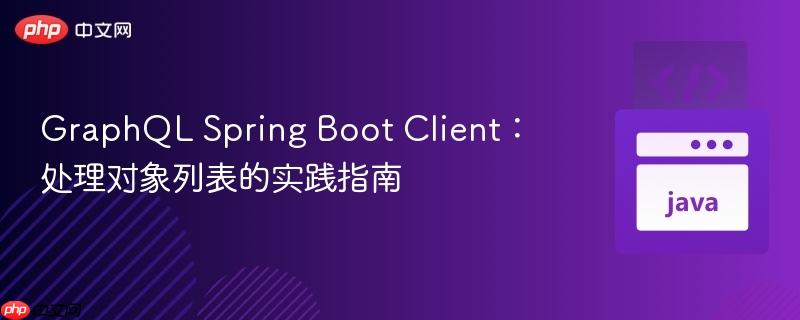
本文档旨在指导开发者如何在spring boot graphql客户端中处理对象列表。我们将探讨如何构建graphql查询以传递对象列表,并提供使用graphqltemplate的示例代码,展示如何配置请求并解析响应,以便在客户端应用中有效地获取和使用graphql服务返回的数据。
在构建GraphQL客户端时,一个常见的需求是向服务器传递对象列表作为查询参数。本文将介绍如何在Spring Boot应用中使用 GraphQLTemplate 处理这种情况。我们将重点关注如何构建GraphQL查询、传递参数以及解析响应。
构建GraphQL查询
首先,我们需要定义GraphQL查询。假设服务端有一个查询 getPersonsByIds,它接收一个 personIds 列表作为参数,并返回一个 Person 对象的列表。查询语句如下:
query($personIds: [BigInteger]) {
getPersonsByIds(personIds : $personIds ) {
firstName
middleName
lastName
birthDt
}
}在这个查询中,$personIds 是一个变量,类型为 [BigInteger],表示一个 BigInteger 类型的列表。服务端需要定义对应的schema,例如:
type Person{
firstName: String
// other fields...
}
type Query {
personList: [Person]
}并且使用 @SchemaMapping 注解来返回对象列表:
@SchemaMapping(typeName = "Query",value = "personList")
public List<Person> getPersonsByIds() {
return personService.getPersonsByIds();
}使用GraphQLTemplate发送请求
接下来,我们将使用 GraphQLTemplate 发送GraphQL请求。以下代码展示了如何构建 GraphQLRequestEntity 并传递 personIds 列表:
@Service
public class PersonService {
private final GraphQLTemplate graphQLTemplate = new GraphQLTemplate();
private final String url = "http://localhost:8084/graphql";
public List<Person> getPersonsByIds(List<BigInteger> personIds) {
GraphQLRequestEntity requestEntity;
try {
requestEntity = GraphQLRequestEntity.Builder()
.url(url)
.requestMethod(GraphQLTemplate.GraphQLMethod.QUERY)
.request("query($personIds: [BigInteger]) {\n" +
" getPersonsByIds(personIds : $personIds ) {\n" +
" firstName\n" +
" middleName\n" +
" lastName\n" +
" birthDt\n" +
" }\n" +
"}"
)
.variables(new Variable<>("personIds", personIds)) // 传递personIds列表
.build();
} catch (MalformedURLException e) {
throw new RuntimeException(e);
}
return graphQLTemplate.query(requestEntity, ResponseGetPersonsByIds.class).getResponse().getGetPersonsByIds();
}
}关键在于 variables 方法的调用。我们将变量名 "personIds" 和实际的 personIds 列表传递给 Variable 构造函数。
定义响应类
为了能够解析GraphQL响应,我们需要定义一个响应类 ResponseGetPersonsByIds。这个类应该包含一个 getPersonsByIds 字段,类型为 List
public class ResponseGetPersonsByIds {
private GetPersonsByIdsResponse response;
public GetPersonsByIdsResponse getResponse() {
return response;
}
public void setResponse(GetPersonsByIdsResponse response) {
this.response = response;
}
public static class GetPersonsByIdsResponse {
private List<Person> getPersonsByIds;
public List<Person> getGetPersonsByIds() {
return getPersonsByIds;
}
public void setGetPersonsByIds(List<Person> getPersonsByIds) {
this.getPersonsByIds = getPersonsByIds;
}
}
}注意事项
总结
通过本文,我们学习了如何在Spring Boot GraphQL客户端中使用 GraphQLTemplate 传递对象列表作为查询参数。关键步骤包括构建GraphQL查询、使用 variables 方法传递参数以及定义响应类。遵循这些步骤,可以轻松地构建GraphQL客户端,并与提供GraphQL API的服务端进行交互。
以上就是GraphQL Spring Boot Client:处理对象列表的实践指南的详细内容,更多请关注php中文网其它相关文章!

每个人都需要一台速度更快、更稳定的 PC。随着时间的推移,垃圾文件、旧注册表数据和不必要的后台进程会占用资源并降低性能。幸运的是,许多工具可以让 Windows 保持平稳运行。




Copyright 2014-2025 https://www.php.cn/ All Rights Reserved | php.cn | 湘ICP备2023035733号